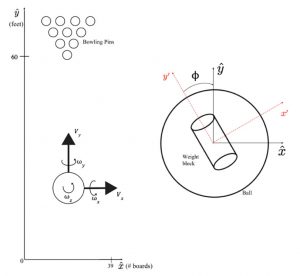Conditions from the makeup of the oil on the lane to the subtle asymmetry of a bowling ball can enhance planning for the next strike.
From the Journal: AIP Advances

WASHINGTON, April 15, 2025 – With millions of dollars at stake across tournaments and more than 45 million regular annual participants, bowling continues to reign as a top sport in the U.S. A unified model that predicts how a bowling ball behaves down the lane, however, remains elusive.
In AIP Advances, by AIP Publishing, researchers from Princeton, MIT, the University of New Mexico, Loughborough University, and Swarthmore College share a model that identifies the optimal location for bowling ball placement. Employing a system of six differential equations derived from Euler’s equations for a rotating rigid body, their model creates a plot that shows the best conditions for a strike.
“The simulation model we created could become a useful tool for players, coaches, equipment companies and tournament designers,” said author Curtis Hooper. “The ability to accurately predict ball trajectories could lead to the discoveries of new strategies and equipment designs.”
To date, most methods for predicting the outcome of bowling shots have relied on statistics describing real-life bowlers, rather than analyzing the dynamics of the ball and shot itself. Such approaches have often come short when players introduce slight variability in how they bowl.
Instead, the group’s model accounts for a variety factors. One example is the thin layer of oil applied to bowling lanes; the oil layer can vary widely in volume and shape between competitive tournaments, requiring specific styles and targeting strategies for each. The oil is seldom applied uniformly, which creates an uneven friction surface.
The issue is that bowlers and coaches can currently only rely on their own experience and instinct, which Hooper said is often imprecise and suboptimal.
“Our model provides a solution to both of these problems by constructing a bowling model that accurately computes bowling trajectories when given inputs for all significant factors that may affect ball motion,” Hooper said. “A ‘miss-room’ is also calculated to account for human inaccuracies which allows bowlers to find their own optimal targeting strategy.”
Making the model posed several challenges, including how to describe the motion of the subtly asymmetric bowling ball. More challenging still was distilling the inputs required for predicting the trajectory into terms that a bowler or coach could understand and that could be measured with accessories bowlers already use.
In the future, the group aims to improve the model’s accuracy by incorporating even more factors, including uneven bowling lanes, as well as connect with professionals in the industry to better understand how the model may be tailored to fit their applications.
###
Article Title
Using physics simulations to find targeting strategies in competitive tenpin bowling
Authors
Simon Si Ming Ji, Shouzhuo Yang, Wilber Dominguez, Curtis George Hooper, and Cacey Stevens Bester
Author Affiliations
Princeton University, MIT, The University of New Mexico, Loughborough University, Swarthmore College
